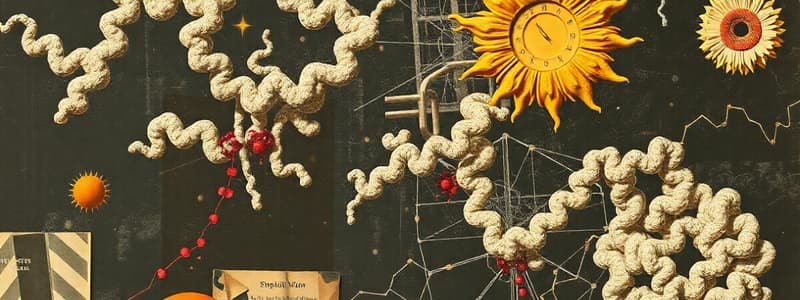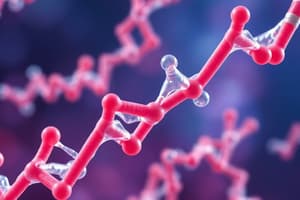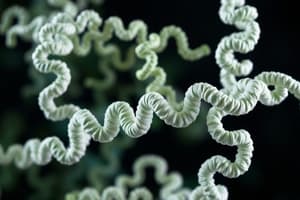Podcast
Questions and Answers
What is a key characteristic of quaternary protein structure?
What is a key characteristic of quaternary protein structure?
- It involves a single polypeptide chain.
- It does not exhibit hydrogen bonding.
- It is only formed by fibrous proteins.
- It results from interactions between multiple polypeptide chains. (correct)
Which of the following correctly describes an advantage of quaternary protein structure?
Which of the following correctly describes an advantage of quaternary protein structure?
- Improved genetic economy and efficiency. (correct)
- Independence of polypeptide chains in function.
- Increase in surface-to-volume ratio.
- Total loss of cooperativity.
Which types of interactions are crucial for stabilizing quaternary protein structures?
Which types of interactions are crucial for stabilizing quaternary protein structures?
- Hydrophobic interactions solely.
- Covalent bonds exclusively.
- Only ionic bonds.
- Hydrogen bonding and disulphide bonds. (correct)
What differentiates globular proteins from fibrous proteins?
What differentiates globular proteins from fibrous proteins?
Why is protein folding considered thermodynamically favorable?
Why is protein folding considered thermodynamically favorable?
What type of reaction leads to the formation of a peptide bond?
What type of reaction leads to the formation of a peptide bond?
Which two amino acids are known to form disulfide bridges?
Which two amino acids are known to form disulfide bridges?
What is the byproduct of the dehydration synthesis reaction that forms a peptide bond?
What is the byproduct of the dehydration synthesis reaction that forms a peptide bond?
How does the structure of a peptide bond affect protein stability?
How does the structure of a peptide bond affect protein stability?
Which of the following hormones is associated with childbirth?
Which of the following hormones is associated with childbirth?
Substance P primarily functions as which type of biological molecule?
Substance P primarily functions as which type of biological molecule?
Which antibiotic is specifically used against gram-negative bacteria?
Which antibiotic is specifically used against gram-negative bacteria?
What is the structure of a peptide bond?
What is the structure of a peptide bond?
What is the role of proline in the formation of alpha helices?
What is the role of proline in the formation of alpha helices?
Which type of beta sheet is characterized by a stronger hydrogen bond network?
Which type of beta sheet is characterized by a stronger hydrogen bond network?
Which residue is considered a strong helix former?
Which residue is considered a strong helix former?
What feature of the alpha helix contributes to its dipole moment?
What feature of the alpha helix contributes to its dipole moment?
Which of the following interactions can affect the structure of an alpha helix?
Which of the following interactions can affect the structure of an alpha helix?
How do side chains in beta sheets orient themselves?
How do side chains in beta sheets orient themselves?
What is the typical number of strands found in globular protein beta sheets?
What is the typical number of strands found in globular protein beta sheets?
Which amino acid is known to terminate alpha helices due to its flexibility?
Which amino acid is known to terminate alpha helices due to its flexibility?
What stabilizes the 180° turn in a beta turn?
What stabilizes the 180° turn in a beta turn?
Which amino acid is commonly found in position 2 of a type 1 beta turn?
Which amino acid is commonly found in position 2 of a type 1 beta turn?
What method is used to measure the secondary structure of proteins?
What method is used to measure the secondary structure of proteins?
How are beta sheet disruptions assessed concerning mutations?
How are beta sheet disruptions assessed concerning mutations?
In Circular Dichroism, what characteristic indicates an alpha helix structure?
In Circular Dichroism, what characteristic indicates an alpha helix structure?
What type of interactions primarily stabilize the tertiary structure of a protein?
What type of interactions primarily stabilize the tertiary structure of a protein?
Which structural feature is characterized by a linear arrangement where electrons flow better when aligned?
Which structural feature is characterized by a linear arrangement where electrons flow better when aligned?
Which amino acid is typically found in position 3 of a type 1 beta turn?
Which amino acid is typically found in position 3 of a type 1 beta turn?
What effect can chaotropic agents such as urea and guanidinium hydrochloride have on proteins?
What effect can chaotropic agents such as urea and guanidinium hydrochloride have on proteins?
What is indicated by the melting curve of a protein during denaturation?
What is indicated by the melting curve of a protein during denaturation?
According to Ken Dill's folding funnel hypothesis, what guides the folding of proteins to their native structure?
According to Ken Dill's folding funnel hypothesis, what guides the folding of proteins to their native structure?
What is the significance of the Levinthal paradox in protein folding?
What is the significance of the Levinthal paradox in protein folding?
What role do internal residues play in protein folding?
What role do internal residues play in protein folding?
What is the primary structural feature of globular proteins that influences their folding?
What is the primary structural feature of globular proteins that influences their folding?
Which amino acids are likely to be found on the surface of globular proteins in contact with water?
Which amino acids are likely to be found on the surface of globular proteins in contact with water?
What is a key characteristic of the collagen protein?
What is a key characteristic of the collagen protein?
Which amino acid is present in high amounts specifically in collagen?
Which amino acid is present in high amounts specifically in collagen?
What is the structure of alpha keratin primarily composed of?
What is the structure of alpha keratin primarily composed of?
How do the alpha helices in coiled-coil motif proteins interact?
How do the alpha helices in coiled-coil motif proteins interact?
What role do disulfide bonds play in alpha keratin?
What role do disulfide bonds play in alpha keratin?
Which of the following best describes the structure of silk fibroin?
Which of the following best describes the structure of silk fibroin?
Flashcards
Alpha Helix Structure
Alpha Helix Structure
A common secondary protein structure where the polypeptide chain forms a right-handed helical coil stabilized by hydrogen bonds between the backbone amide and carbonyl groups of every fourth amino acid.
Helix Stability Factors
Helix Stability Factors
The stability of an alpha helix is influenced by the amino acid sequence, with certain amino acids promoting or hindering helix formation.
Helix Breakers
Helix Breakers
Certain amino acids like Proline and Glycine tend to disrupt alpha-helical structures due to steric hindrance or flexibility issues.
Beta Sheet Structure
Beta Sheet Structure
Signup and view all the flashcards
Beta Sheet Stabilizing Interactions
Beta Sheet Stabilizing Interactions
Signup and view all the flashcards
Parallel Beta Sheets
Parallel Beta Sheets
Signup and view all the flashcards
Antiparallel Beta Sheets
Antiparallel Beta Sheets
Signup and view all the flashcards
Helix Dipole
Helix Dipole
Signup and view all the flashcards
Amino Acids
Amino Acids
Signup and view all the flashcards
Peptide Bond
Peptide Bond
Signup and view all the flashcards
Protein Synthesis
Protein Synthesis
Signup and view all the flashcards
Hormones
Hormones
Signup and view all the flashcards
Insulin
Insulin
Signup and view all the flashcards
Oxytocin
Oxytocin
Signup and view all the flashcards
Neuropeptides
Neuropeptides
Signup and view all the flashcards
Substance P
Substance P
Signup and view all the flashcards
Antibiotics
Antibiotics
Signup and view all the flashcards
Polymyxin
Polymyxin
Signup and view all the flashcards
Bacitracin
Bacitracin
Signup and view all the flashcards
Peptide bond form
Peptide bond form
Signup and view all the flashcards
Disulfide Bridge
Disulfide Bridge
Signup and view all the flashcards
Amino Acids with sulfur
Amino Acids with sulfur
Signup and view all the flashcards
Protein Folding
Protein Folding
Signup and view all the flashcards
Globular Proteins
Globular Proteins
Signup and view all the flashcards
Fibrous Proteins
Fibrous Proteins
Signup and view all the flashcards
Quaternary Structure
Quaternary Structure
Signup and view all the flashcards
Protein Stability
Protein Stability
Signup and view all the flashcards
Hydrogen Bonding
Hydrogen Bonding
Signup and view all the flashcards
Disulfide Bonds
Disulfide Bonds
Signup and view all the flashcards
Cooperative Binding
Cooperative Binding
Signup and view all the flashcards
Haemoglobin
Haemoglobin
Signup and view all the flashcards
Aligned Electrons
Aligned Electrons
Signup and view all the flashcards
Antiparallel B-sheet
Antiparallel B-sheet
Signup and view all the flashcards
B-turns
B-turns
Signup and view all the flashcards
B-turn Stabilizing
B-turn Stabilizing
Signup and view all the flashcards
Proline in B-turns
Proline in B-turns
Signup and view all the flashcards
Circular Dichroism (CD)
Circular Dichroism (CD)
Signup and view all the flashcards
CD Measurement
CD Measurement
Signup and view all the flashcards
Alpha Helix CD
Alpha Helix CD
Signup and view all the flashcards
Beta Sheet CD
Beta Sheet CD
Signup and view all the flashcards
Random Coil CD
Random Coil CD
Signup and view all the flashcards
Protein Tertiary Structure
Protein Tertiary Structure
Signup and view all the flashcards
Tertiary Structure Stabilizers
Tertiary Structure Stabilizers
Signup and view all the flashcards
Protein Denaturation
Protein Denaturation
Signup and view all the flashcards
Protein Melting Temperature (Tm)
Protein Melting Temperature (Tm)
Signup and view all the flashcards
Melting Curve
Melting Curve
Signup and view all the flashcards
Protein Folding
Protein Folding
Signup and view all the flashcards
Globular proteins
Globular proteins
Signup and view all the flashcards
Levinthal Paradox
Levinthal Paradox
Signup and view all the flashcards
Protein Folding Funnel
Protein Folding Funnel
Signup and view all the flashcards
Ramachandran plot
Ramachandran plot
Signup and view all the flashcards
Thermodynamics of Protein Folding
Thermodynamics of Protein Folding
Signup and view all the flashcards
Fibrous proteins
Fibrous proteins
Signup and view all the flashcards
Hydrophobic Effect
Hydrophobic Effect
Signup and view all the flashcards
Collagen
Collagen
Signup and view all the flashcards
Elastin
Elastin
Signup and view all the flashcards
Protein Sequencing Methods
Protein Sequencing Methods
Signup and view all the flashcards
Alpha Helix Coiled-Coil
Alpha Helix Coiled-Coil
Signup and view all the flashcards
Alpha Keratin
Alpha Keratin
Signup and view all the flashcards
Silk Fibroin
Silk Fibroin
Signup and view all the flashcards
Study Notes
Protein Structure and Function
- Proteins are versatile macromolecules found in all living organisms, with diverse functions in biological processes.
- Proteins are the main agents of biological function, performing various roles such as catalysis, transport, structure, and motion.
Catalysis
- Catalysis is the acceleration of chemical reactions by a catalyst, a substance that increases the reaction rate without being consumed.
- Enzymes are proteins that act as catalysts in biological systems, speeding up biochemical reactions.
- Examples include enolase in glycolysis and DNA polymerase in DNA replication.
Transport
- Proteins facilitate the transport of molecules across cell membranes or within the body.
- Haemoglobin transports oxygen in the blood.
- Lactose permease transports lactose across cell membranes.
Structure
- Proteins provide structural support and shape to cells and tissues.
- Examples include collagen (connective tissue) and keratin (nails, hair, feathers, and horns).
Motion
- Proteins are essential for cellular movement and motility.
- Myosin and actin are involved in muscle contraction.
- Other proteins are involved in various types of cell movement.
Protein Structure
- Amino acids are the building blocks of proteins.
- The primary structure is the linear sequence of amino acids in a polypeptide chain.
- The secondary structure involves interactions like alpha-helices and beta-sheets, formed by hydrogen bonding between amino acids.
- The tertiary structure is the three-dimensional shape of the entire polypeptide chain.
- The quaternary structure is the arrangement of multiple polypeptide subunits in a protein complex.
Amino Acids
- There are 20 common amino acids.
- Each has a central carbon atom (alpha carbon) bonded to four groups: an amino group, a carboxyl group, a hydrogen atom, and a variable side chain (R group), which creates the diversity among the 20 different amino acids
- Knowledge of their names, structures, and properties is crucial for understanding protein function.
Chirality
- Most amino acids are chiral, meaning they have four different substituents around the alpha carbon, and thus exist in two isomeric forms (L and D). Only L-forms appear in proteins.
Common Amino Acids Classification
- Common amino acids can be grouped into five categories based on their R-group characteristics: nonpolar, aliphatic, aromatic, polar, uncharged, positively charged, and negatively charged.
Peptide Bonds
- Peptide bonds form between the carboxyl group of one amino acid and the amino group of the next amino acid in a polypeptide chain.
- The peptide bond has characteristics of partial double bond character and resonance, which affects the structure and stability of the protein.
Unusual Amino Acids
- Certain amino acids are not produced by standard ribosome processes.
- Arise by post-translational modifications.
- Example: selenocysteine and pyrrolysine.
Peptide Ends
- Peptides have amino and carboxyl termini, crucial for directing and regulating other protein functions.
- Numbering and naming of amino acids starts from the amino terminus (N terminus).
Protein Folding
- Protein folding leads to a three-dimensional structure necessary to function.
- The hydrophobic effect plays a significant role in protein folding by pushing hydrophobic side chains towards the interior of the protein.
- Hydrogen bonding between amino acid residues can further stabilize protein structure.
Denaturation
- Denaturation is the process where proteins lose their three-dimensional structure.
- Denaturation is often caused by heat, pH extremes, organic solvents, and chemicals called chaotropes
- Loss of function in protein commonly happens with denaturation.
Protein Synthesis
- Synthesis occurs from C terminus to N terminus.
- Signal sequence directs protein to specific locations within cell.
- Proteins are often modified after synthesis.
Protein Sequencing
- Determines the order of amino acids in a protein.
- Methods such as Edman degradation and mass spectrometry.
Studying That Suits You
Use AI to generate personalized quizzes and flashcards to suit your learning preferences.





